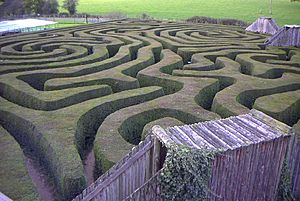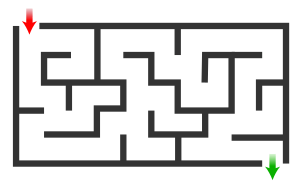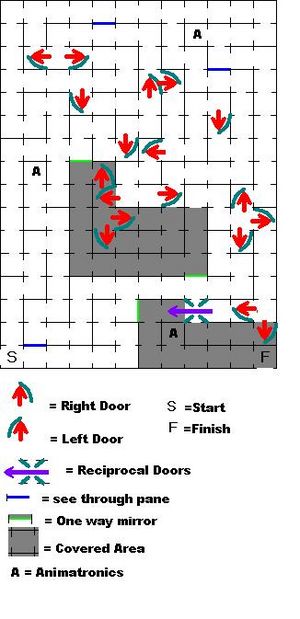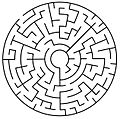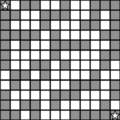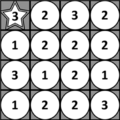Maze facts for kids
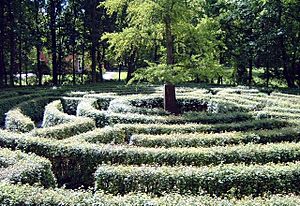
A maze is a special path or a group of paths. It usually has an entrance and a goal you need to reach. The word "maze" can mean two things:
- A puzzle with many paths that split off, where you have to find the right way.
- A simpler path that doesn't split, but winds around in a tricky way to get you to the end.
Sometimes, the word "labyrinth" is used to mean the same thing as "maze." Mazes usually have walls and paths that stay the same. But some puzzles where the walls can move are also called mazes.
Contents
Building Mazes: How Are They Made?
Mazes can be built from many different things! People have made them with:
- Walls and rooms, like in a building.
- Tall hedges or bushes.
- Patterns cut into grass fields.
- Tall corn or maize stalks.
- Hay bales, books, or even snow!
Corn mazes can be very big. They are usually only around for one growing season, so they can be different each year. They are popular places for tourists to visit in the fall.
Inside buildings, you might find mirror mazes. These mazes use many mirrors to create confusing paths. It's hard to tell which way is real and which is just a reflection!
Another type of maze is made of rooms connected by doors. You start in one room and try to reach a specific exit or a special spot. Mazes can also be drawn on paper for you to solve with a pencil or your finger.
Creating Mazes: Designing the Puzzle
Designing a maze means planning where the paths and walls will go. There are many ways to create mazes, either by hand or using a computer.
There are two main ways to make a maze:
- Carving passages: This is like drawing the paths first. You decide where people can walk.
- Adding walls: This is like placing blocks or barriers in an open space. The empty spaces between the walls become the paths.
Most mazes you see drawn on paper are made by drawing the walls. The white spaces are the paths you follow.
Solving Mazes: Finding the Way Out
Solving a maze means finding a path from the start to the finish. Some ways to solve mazes are for people who are actually inside the maze and can't see the whole thing. Other ways are for people or computers who can see the entire maze at once.
A famous mathematician named Leonhard Euler was one of the first to study mazes using math. He helped create a field of math called topology, which looks at shapes and spaces.
Mazes that don't have any loops are called "perfect" mazes. These are like a "tree" in math terms, where there's only one path between any two points. Many ways to solve mazes are connected to this idea of "graph theory."
Different Kinds of Mazes
There are many fun and unique types of mazes:
- Ball-in-a-maze puzzles: These are tricky games where you guide a small ball through a maze using your hands.
- Block maze: In this maze, you have to move or add blocks to create a clear path.
- Hamilton maze: The goal here is to find a special path that visits every single point or "room" in the maze exactly once.
- Linear or railroad maze: These mazes have paths like train tracks with switches. You can only move forward, not backward.
- Logic mazes: These mazes have special rules for moving, not just "don't cross the lines." For example, you might only be able to move if a number is even.
- Loops and traps maze: These mazes have one-way doors. Some doors lead to the right path, but others might send you back to the start! You can't go back through a door once you've entered.
- Mazes in higher dimensions: Imagine a maze that goes up and down, not just left and right! A maze with bridges is three-dimensional. Some natural cave systems are like 3D mazes. Video games like Descent use mazes that are fully three-dimensional.
- Number maze: In this maze, numbers tell you how many steps to jump. You might jump across the maze many times to find the path.
- Picture maze: This is a regular maze, but when you solve it, the path you took forms a picture!
- Turf mazes and mizmazes: These are patterns cut into grass fields. They look like a long rope folded up, without any places where paths cross or split.
Gallery
Images for kids
-
Public maze at Wild Adventures theme park, Valdosta, Georgia, United States.
-
Maze at Missouri Botanical Garden in St. Louis
See also
 In Spanish: Laberinto (pasatiempo) para niños
In Spanish: Laberinto (pasatiempo) para niños



